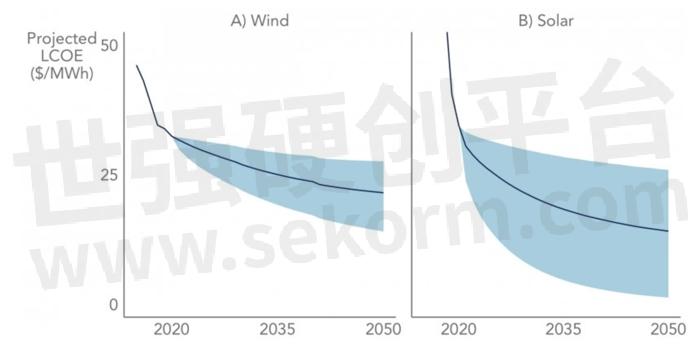Trends in Wind Power Generation

In our review of today’s trends in power electronics, we discussed the growth in the renewable energy market and the resulting increased investment in renewable energy technologies, such as wind. As a result, global demand for wind power is surging. To keep pace, not only are there more wind turbines being installed onshore and offshore, but the generation capacity of each turbine is also growing substantially. This is changing the requirements for the power electronics needed for these systems. In this blog, we review some of the key wind power generation trends fueling the ability to provide increased capacity and driving changes in the power electronics required for these systems.

A Significant Decrease in the Levelized Cost of Energy
To calculate the average total cost to build and operate a power-generating asset versus the asset’s total energy output over its lifespan, a metric known as the levelized cost of energy (LCOE) is used. LCOE provides a way to compare different energy generation sources. In general, energy providers will pay a premium for systems that are more reliable and have a longer life span. Over the past decade, technological advancements, operational improvements, and power generation capacity for wind have all improved, significantly decreasing the LCOE for wind.

Figure 1. Projected LCOE for wind and solar as calculated by the US Department of Energy.
Increased Turbine Power Levels
The demand for more power output per turbine has significantly increased over the last two decades. As a result, the power generation capability of wind turbines, which is fueled by technological advancements in Converters, has quickly grown (Figure 2). In 2023, onshore converters were released that had a power generation capacity of 8.5MW while offshore converters were reaching 18MW.

Figure 2. The development trend of wind turbine output and power electronics technology for onshore wind turbines.
Offshore is Now an Easier Option
Since 2013, global offshore wind capacity has grown nearly 9X to around 60 GW. The Global Wind Energy Council predicts capacity will increase by another 6X to 360GW in the next decade. Led by Europe and China, offshore wind farms have become an attractive option since larger turbines can be placed offshore to take advantage of stronger winds and the fact that there are not any neighbors nearby who may be upset by seeing or hearing the turbines.
Floating Platforms for Deep Water
Further driving the increase in offshore installations is the placement of turbines in deep water using floating platforms. Deep water installations are poised to be a critical part of the global renewable energy strategy since winds are more powerful and more consistent as you get further offshore. However, the harsh environments where these platforms live can make maintenance of these installations a challenge. Therefore, designers for these turbines must place a premium on reliability and uptime for all components.
Extended Lifetime and Increased Reliability
As discussed, LCOE is a key metric for all energy sources. To continue to enhance cost competitiveness for wind energy, all components used in turbines, especially those that are installed offshore or in other remote locations, must be designed for long-term reliability.
More Efficient Converters are Now Needed
Converters are a crucial part of a wind turbine as these components ensure grid stability, increase turbine efficiency, and provide energy production flexibility. As power output increases, converters must evolve to become modular systems capable of running at higher voltages.
Hybrid Systems and Battery Energy Storage Systems
The intermittency of wind energy can be challenging; therefore, the pairing of wind farms with battery energy storage systems (BESS) is becoming more common. This is an excellent combination because hybrid systems can help balance power supply and demand and provide more consistent energy output, while a BESS can store excess power generated at times of high wind and then release it as needed.
High-Voltage DC Transmission Lines
The efficient movement of power from the place it is generated to the places it is used is crucial, especially as wind farms are increasingly installed further away from people. To do this, high-voltage DC (HVDC) transmission lines are needed.
Stay tuned as we expand on the impact of some of these trends on the power conversion systems required in wind turbines in the future.
- +1 Like
- Add to Favorites
Recommend
- Why Choose ZOEYGO DC-DC Converters?
- Unlocking the Power of Bidirectional Converters
- Most Common Wholesale DC-DC Converters
- How AC-DC Converters Evolved
- Understanding Buck and Boost Converters and the Capacitors Behind Them
- Exploring the Function and Applications of Bidirectional Converters in Electrical Engineering
- Wholesale AC-DC Converters Make Your Equipment More Convenient
- 24V AC to DC Converter: Converting Alternating Current to Direct Current
This document is provided by Sekorm Platform for VIP exclusive service. The copyright is owned by Sekorm. Without authorization, any medias, websites or individual are not allowed to reprint. When authorizing the reprint, the link of www.sekorm.com must be indicated.















































































































































































































































































































































































































































































































































































































































































































































































































































